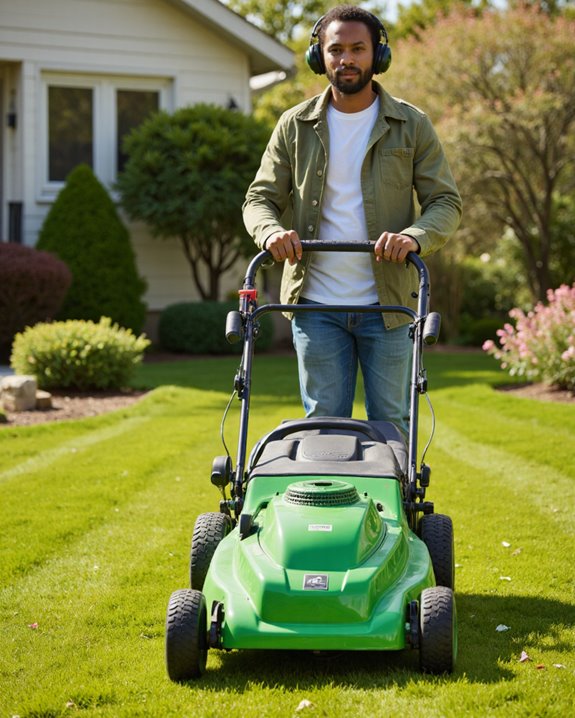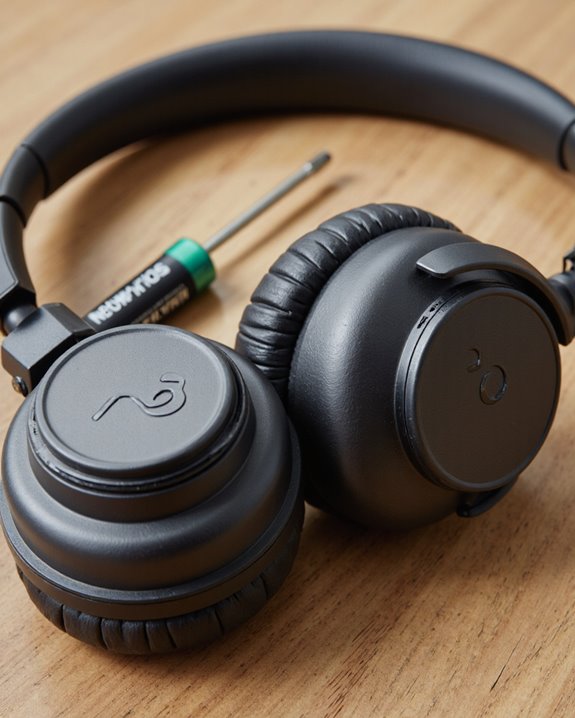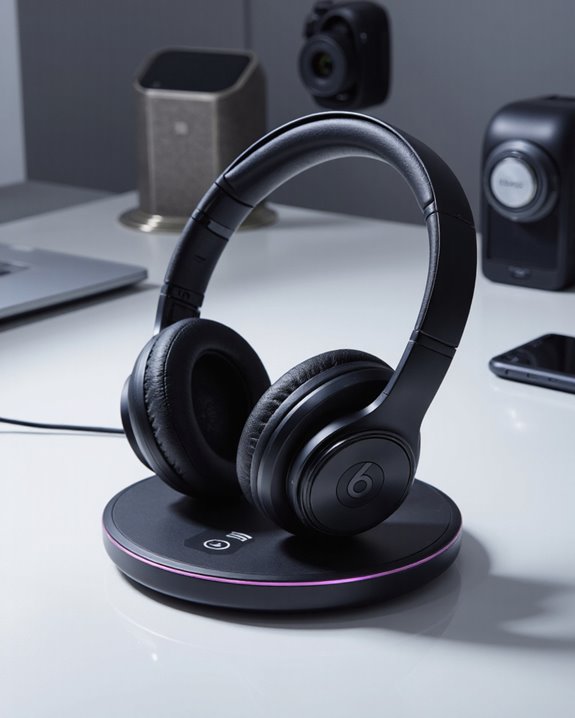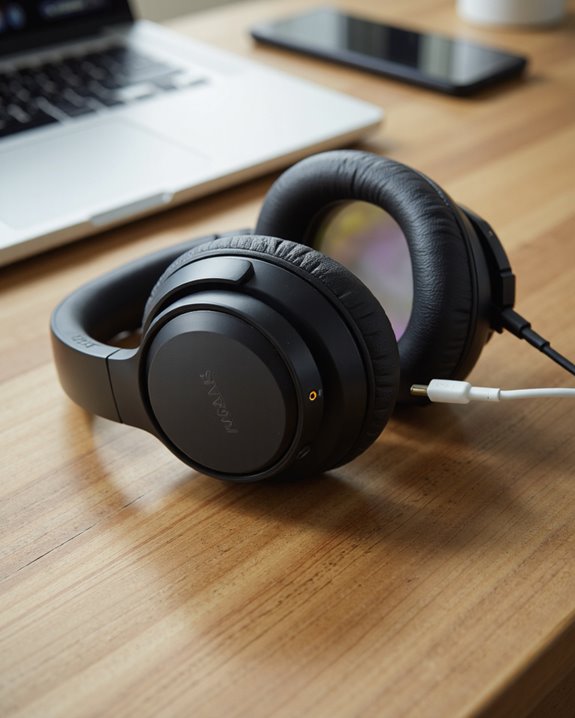As an Amazon Associate, we earn from qualifying purchases. Some links may be affiliate links at no extra cost to you. Although our opinions are based on curated research, we haven't used these products. Articles generated with AI.

Are Bose QuietComfort Headphones Water Resistant?
No, Bose QuietComfort Headphones aren’t water resistant; they don’t carry any official IP rating for dust or moisture protection. These over-ear models prioritize advanced noise cancellation and acoustic performance, lacking protective seals or materials against splashes or sweat. Comparatively, Bose QuietComfort Earbuds feature an IPX4 rating, offering limited splash resistance, while the headphones don’t. To maintain longevity, we should keep them in dry environments and avoid water exposure. For more details on durability and care, let’s examine their design further.
Key Takeaways
- Bose QuietComfort Headphones do not have an official water resistance (IP) rating.
- They are not designed to withstand water, sweat, or heavy moisture exposure.
- Moisture can damage internal components and compromise performance.
- For workouts or wet environments, Bose QuietComfort Earbuds with IPX4 rating are a better choice.
- Always use and store QuietComfort Headphones in dry, controlled conditions to ensure longevity.
Understanding Ingress Protection (IP) Ratings
Although we often see water- and dust-resistance claims on electronic devices, understanding what those claims actually mean requires familiarity with Ingress Protection (IP) ratings. An IP rating quantifies a device’s protection against solid particles and liquids using two digits. The first digit (0–6) indicates dust resistance; for example, a rating of 5 means limited dust ingress is permitted, but it won’t interfere with device operation. The second digit (0–9) measures water resistance, from minimal moisture to full submersion—an IPX4 rating, for instance, indicates resistance to splashes but not immersion. Devices with higher ratings, such as IP67, are considered effectively waterproof for short periods. If a product lacks an IP rating, we shouldn’t assume it has reliable protection against dust or water.
Bose QuietComfort Headphones: Water and Dust Protection
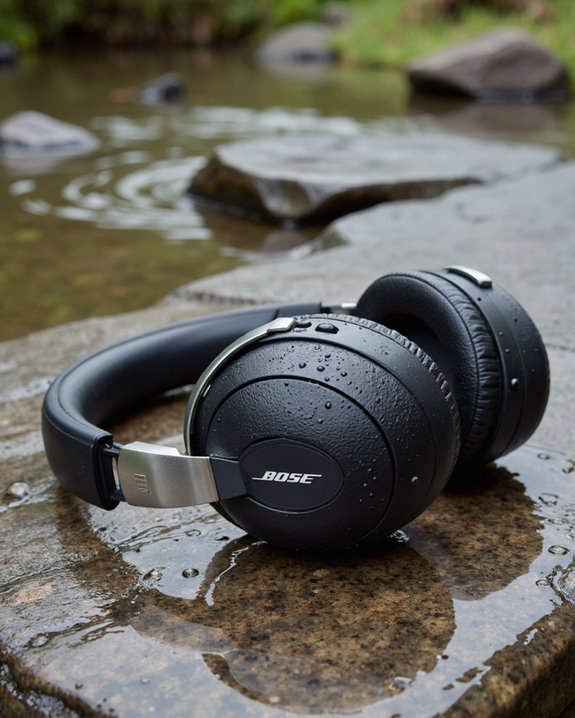
When evaluating the water and dust protection of Bose QuietComfort Headphones, it’s important to note that these headphones don’t carry any official Ingress Protection (IP) rating. This lack of certification means they’re not engineered to withstand water exposure or prevent dust intrusion. Bose prioritizes exceptional noise cancellation and audio quality, but water resistance isn’t integrated into the QuietComfort design. As a result, it’s essential that we keep these headphones away from moisture, including rain, sweat, or accidental splashes. Using them in wet environments can compromise internal components and diminish performance. For ideal longevity and sustained noise isolation, we should always store and use our QuietComfort headphones in dry, controlled conditions, ensuring both reliability and the preservation of their advanced features.
Comparing Water Resistance Across Bose Products
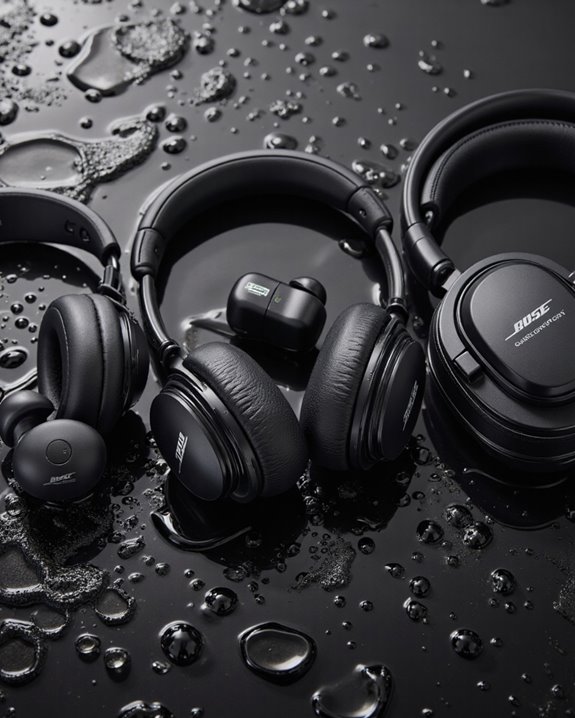
While evaluating Bose’s diverse lineup, it’s clear that water resistance varies considerably between their over-ear headphones and true wireless earbuds. The Bose QuietComfort Ultra Headphones, like other models in the QuietComfort series, lack an IP rating and aren’t designed to be splash resistant. Their focus remains on delivering exceptional audio performance, advanced noise cancelling technology, and a comfortable fit, rather than water resistance. On the other hand, the Bose QuietComfort Earbuds stand out with an IPX4 rating, meaning they’re splash resistant and can handle sweat or light rain. This distinction makes the earbuds more suited for workouts or outdoor use, especially when Bose QuietComfort Earbuds charging on the go. For those prioritizing water resistance, earbuds are a safer choice than over-ear headphones in the Bose lineup.
The Role of Design in Over-Ear Headphone Durability
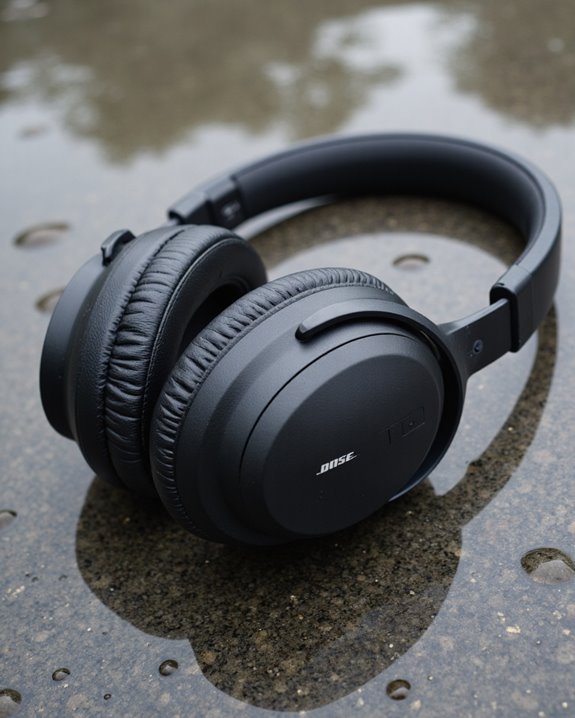
Given the sophisticated engineering behind over-ear headphones like the Bose QuietComfort series, design choices play a crucial role in determining their overall durability—especially regarding water resistance. Over-ear headphones require venting for acoustic tuning, which directly affects their water resistant properties. Unlike simpler earbud designs, these headphones incorporate intricate components and materials that enhance audio quality and comfort but make true waterproofing difficult. The seals necessary for effective Active Noise Cancelling also present challenges, as they must block sound while minimizing water ingress. This means that, by prioritizing acoustic integrity and long-term comfort, manufacturers often accept trade-offs that limit water resistance. As a result, it’s essential that we avoid exposing our premium over-ear headphones to moisture, ensuring their durability and peak performance over time. For example, models like the Beats Studio Pro emphasize Active Noise Cancelling capabilities which inherently complicate full water resistance.
Active Noise Cancellation and Audio Features
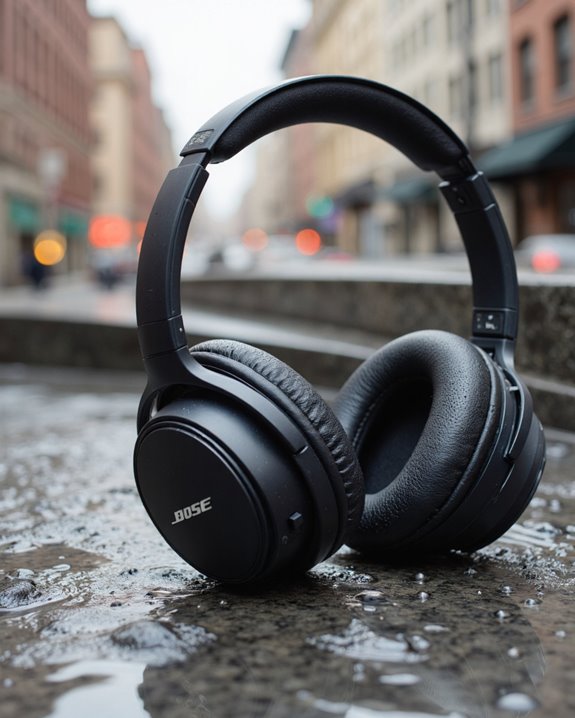
Although the Bose QuietComfort Headphones are celebrated for their comfortable fit and refined design, it’s their advanced audio features—particularly the active noise cancellation (ANC)—that truly set them apart in the premium over-ear segment. Bose’s Acoustic Noise Cancelling™ technology uses external microphones to detect environmental sounds and generates opposite signals, effectively neutralizing unwanted noise. We can select between Quiet Mode, which delivers near-total isolation by blocking environmental sounds, and Aware Mode, which allows us to stay attuned to our surroundings without removing the headphones. There’s also a customizable mode to tailor ANC levels, creating a personalized listening experience. High-fidelity audio is guaranteed through volume-optimized Active EQ and proprietary acoustic architecture, so we enjoy consistent sound quality at any listening level. Additionally, multiple silicone tip sizes ensure a customized fit that enhances noise isolation and comfort during extended use.
Best Practices for Using Bose QuietComfort Headphones
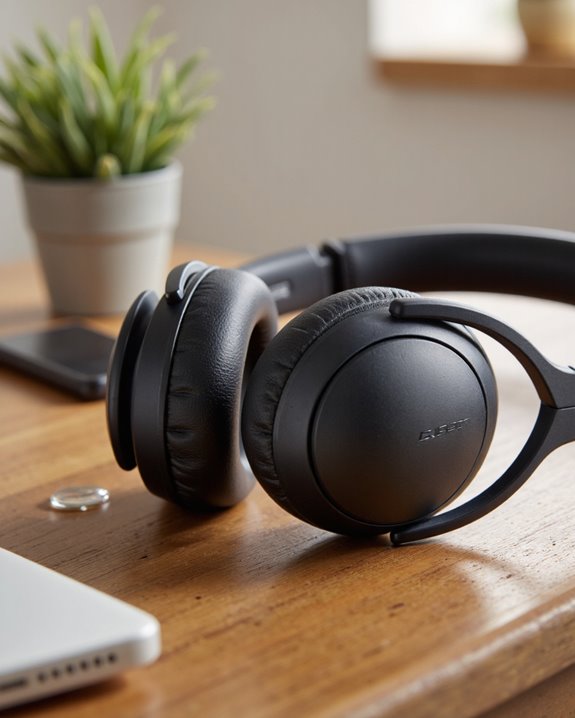
To get the most out of the Bose QuietComfort Headphones’ advanced noise cancellation and audio features, we need to establish proper care and usage habits that align with their design specifications—especially since these headphones aren’t built to withstand moisture. Because Bose products like these lack water resistance or ingress protection ratings, it’s essential to keep them away from water and damp environments. Let’s always store our headphones in a dry location and use a protective case when transporting them, as this shields them from accidental spills or exposure. Regularly cleaning the ear cups and cushions with a dry cloth helps preserve hygiene while preventing moisture buildup that could compromise performance. By following these best practices, we maximize both the longevity and the consistent audio quality of our headphones.
Choosing the Right Headphones for Wet Environments
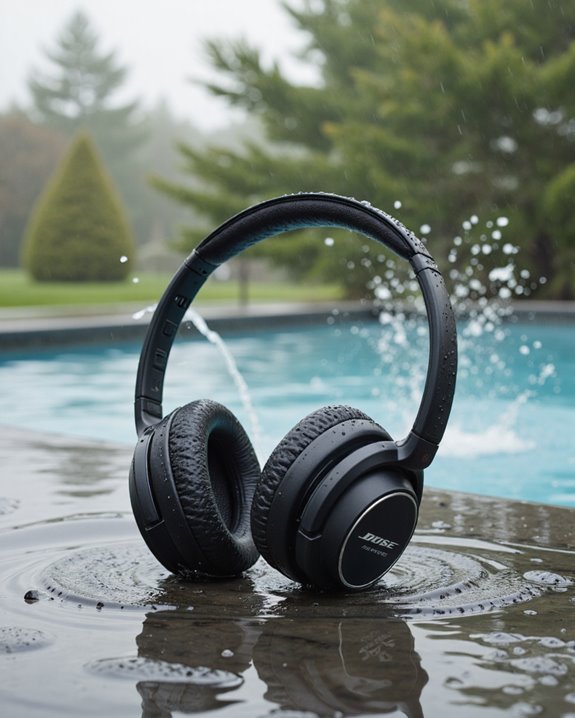
When we’re selecting headphones for use in wet environments, it’s critical to contemplate models with defined water resistance ratings that indicate their ability to withstand moisture exposure. An official IP rating—such as IPX4 for splash resistance or IPX7 for immersion protection—gives us a measurable standard. The Bose QuietComfort® Earbuds charging case and headphones, for instance, lack an IP rating, making them unsuitable for consistent sweat protection or rain exposure. As we weigh options, we should prioritize sound quality and comfort, but guarantee the headphones also match our activity level. Always review the manufacturer’s specifications to confirm if water resistant features are included. For active noise cancellation in damp conditions, opt for earbuds or headphones specifically built with adequate water protection. Models like the SHOKZ OpenRun provide an IP67 water-resistant design combined with lightweight comfort, making them ideal for workouts in wet conditions.
Frequently Asked Questions
Is the Bose Quietcomfort Water Resistant?
When we look at Bose QuietComfort, we find no water resistance features or moisture protection technology, which affects headphone durability. User reviews and Bose product comparison highlight their sound quality, but for outdoor usage, maintenance tips recommend avoiding moisture exposure.
What Happens if My Bose Headphones Get Wet?
If our Bose headphones get wet, water damage can harm sound quality and void warranty coverage. For headphone care, let’s dry them with a soft cloth, air dry fully, and follow moisture protection and maintenance tips from user experiences.
Can You Wear Bose Quietcomfort in the Shower?
We shouldn’t wear Bose QuietComfort headphones in the shower due to shower safety and moisture damage risks. For headphone care and audio quality, let’s consider product limitations, user experiences, maintenance tips, and alternative options like waterproof earbuds instead.
Is the Bose Quietcomfort Ultra Headphones Water Resistant?
When we consider Bose QuietComfort durability and headphone water protection, it’s clear these headphones aren’t water resistant. For ideal audio quality and moisture damage prevention, let’s follow headphone maintenance tips, best usage practices, and user experiences, especially outdoors.

